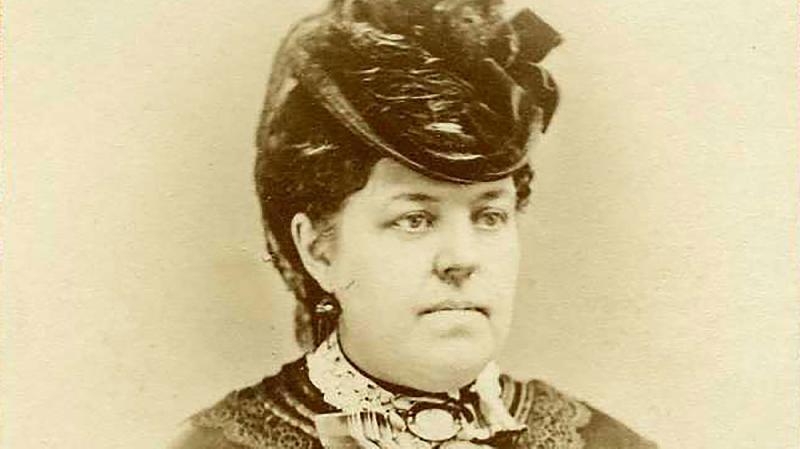*(CNN) — Esther Howland isn’t a household name for most Americans. But those who’ve studied the history behind the intricate, hand-crafted (Valentine’s Day) cards she started making some 175 years ago argue that she should be.
“She was the Martha Stewart of her day. She would have killed it on Etsy,” says Vanessa Bumpus, exhibit coordinator at the Worcester Historical Museum in Massachusetts.
Howland lived in Worcester and built a business in the central Massachusetts city that brought fame and fortune in her lifetime, and a nickname that lasted long after her 1904 death: “The mother of the American valentine.”
Howland didn’t invent valentines or bring them to the United States. But she’s credited with sparking the spread of the ornate cards that became a staple of Valentine’s Day celebrations here and eventually blossomed into a multi-billion-dollar industry.
“She was a visionary. A lot of what we think about as valentines were things that she made,” says Nancy Rosin, president of the National Valentine Collectors Association. “She popularized the valentine in America.”
And she did it with style.
“There were many, many layers of lace and many elaborate embellishments,” Rosin says.
Tiny pieces of paper were folded like accordions to make the layers of the card pop up. Brightly-colored paper wafers placed beneath lace accentuated the intricate designs. Higher-end cards included “ribbon trimmings, pages of artistic illustrations, hidden doors, and gilded lace,” according to a post describing Howland’s work on the Library of Congress website.
Many of Howland’s designs were labeled with a trademark red H. Rosin says she’s able to recognize others that are likely Howland’s work but don’t have the markings.

“I don’t think she signed them until she started getting competition,” Rosin says.
And the message was always tucked away inside.
Rosin says it’s not just the artistry of Howland’s valentines that captures the attention of collectors; it’s the story behind them.
“She was really quite the entrepreneur,” Rosin says in a video describing Howland’s work for the Huntington Library in suburban Los Angeles, which is home to thousands of valentines and ephemera Rosin donated, including hundreds of Howland’s cards.
The Valentine’s assembly line
Howland graduated from Mount Holyoke in 1847. As the story goes, she was inspired by a valentine she received from England that year.
“She thought, ‘I could do that,’” Bumpus says. And so Howland, whose father owned a stationery store, set about making valentines of her own. She persuaded her father to order materials and enlisted the help of other women on the third floor of her family’s home.
“They sat in rows on either side of tables, just literally passing the valentines down so each person could add their thing… She’s doing it before Henry Ford. They’ve got assembly lines going,” Bumpus says.
The process was more efficient, but still done by hand, leading to some inconsistencies. No two cards were alike, Bumpus says.
“She’s fresh out of school, launching her own business. It’s kind of word of mouth at the beginning,” Bumpus says.
But once Howland started advertising, the popularity of her valentines grew. Before long, they were sold across the country, according to Rosin, who’s shared a history of Howland on her website.
The achievement is even more notable given when it happened. As a biography on Mt. Holyoke’s website notes, Howland pioneered an industry “at a time when most women didn’t have the opportunity to be employed, let alone lead.”
Eventually, Howland partnered with Edward Taft, whose family had also been making valentines, to form the New England Valentine Company.
The George C. Whitney Company — also based in Worcester — bought that company around 1880, and Howland left the valentine business to care for her ailing father.
She died in 1904 at age 75.
“She never marries, which we always find ironic,” Bumpus says. “But her business was a big success.”
And the city where Howland started her company was known for years as the Valentine capital of the United States until paper shortages in World War II sent business grinding to a halt.
The ‘Queen of Valentine’s’ legacy remains
While many Americans might not be familiar with Howland today, it’s a different story in Worcester.
The room where the City Council meets is even named after Howland, Bumpus says.
She isn’t the only famous person to emerge from Worcester. The city was also once home to the father of modern rocketry and the inventor of the smiley face. But in February, Bumpus says, Howland is the star of the show. The city’s history museum offers free admission in her honor.
“Esther is really kind of our queen of valentines around here. We put her up on a pedestal,” Bumpus says.
Adults meet up at a local brewery and at the museum for card-making workshops. And kids from local schools design cards of their own as they learn about Howland’s story. This year they submitted hundreds of designs to the 45th annual Valentine design contest sponsored by the museum and the library.
Some emulated Howland’s style. Others took a more modern approach.
“We have some Pokemon. We have some New England Patriots. This year, we have a lot of Minecraft,” Bumpus says. “It’s nice to see how every year the trends change.”
But one thing remains constant: Pride in Howland’s legacy.
MORE NEWS ON EURWEB: Here’s Why Valentine’s Day Candy is So Expensive | VIDEO
The-CNN-Wire
™ & © 2024 Cable News Network, Inc., a Warner Bros. Discovery Company. All rights reserved.
We Publish News 24/7. Don’t Miss A Story. Click HERE to SUBSCRIBE to Our Newsletter Now!







